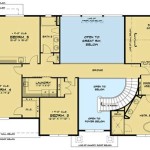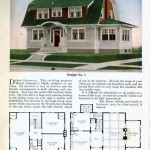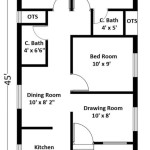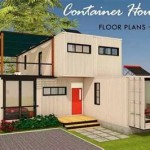A one room house plan is a minimal living space that features a single room as the central and only living area. This room serves multiple functions, combining the living room, bedroom, kitchen, and dining area into one shared space. An example of a one room house plan is a studio apartment, where all living functions take place within one large room.
One room house plans offer several advantages. They are typically smaller in square footage than traditional homes, resulting in lower construction and utility costs. This makes them ideal for individuals or couples living on a budget or with limited space. Additionally, the open layout promotes a sense of connection and togetherness, as there are no separate rooms to divide occupants.
In the following sections, we will explore the benefits and considerations of one room house plans, discuss design tips for maximizing space and functionality, and provide examples of successful one room living environments.
One room house plans offer a unique and efficient way of living in a small space. Here are 9 important points to consider about one room house plans:
- Minimalist and efficient
- Lower construction costs
- Reduced utility bills
- Promotes togetherness
- Challenges with privacy
- Limited storage space
- Requires careful planning
- Multifunctional furniture
- Smart storage solutions
One room house plans can be a great option for those seeking a simple and affordable living space, but it’s important to carefully consider the advantages and challenges before making a decision.
Minimalist and efficient
One room house plans embrace minimalist living, emphasizing functionality and eliminating unnecessary possessions. By combining multiple living areas into one, these plans maximize space utilization and reduce clutter. This streamlined approach promotes a sense of openness and tranquility, allowing residents to focus on what truly matters.
The efficient design of one room house plans extends beyond space optimization. By eliminating walls and partitions, these plans facilitate natural light flow, reducing the need for artificial lighting and creating a brighter, more inviting living environment. Additionally, the open layout promotes better air circulation, contributing to a healthier and more comfortable indoor atmosphere.
Furthermore, one room house plans minimize energy consumption. With a smaller footprint and fewer exterior walls, these homes require less energy to heat and cool. This not only reduces utility bills but also contributes to environmental sustainability.
Overall, the minimalist and efficient nature of one room house plans offers numerous advantages, including space optimization, improved natural lighting and air circulation, reduced energy consumption, and a simplified lifestyle.
Lower construction costs
Reduced materials and labor
One room house plans require significantly less building materials compared to traditional homes with multiple rooms and separate spaces. This reduction in materials translates directly into lower construction costs. Additionally, the simplified design of one room house plans minimizes the need for specialized labor, such as framers and electricians, further reducing labor expenses.
Smaller foundation and footprint
The compact size of one room house plans results in a smaller foundation and overall footprint. This not only reduces the amount of concrete and excavation required, but also lowers the cost of land acquisition. In areas where land prices are high, this can represent a substantial saving.
Simplified roof structure
One room house plans typically feature a simpler roof structure compared to homes with multiple rooms and complex rooflines. This simplified design requires less roofing materials and reduces the need for specialized roofing contractors, leading to lower construction costs.
Fewer windows and doors
The reduced size and open layout of one room house plans result in fewer windows and doors. This not only lowers the cost of purchasing and installing windows and doors, but also reduces the cost of framing and finishing these openings.
Overall, the reduced materials, labor, foundation size, roof structure, and number of windows and doors contribute to significantly lower construction costs for one room house plans.
Reduced utility bills
Energy-efficient design
One room house plans are inherently energy efficient due to their compact size and reduced exterior surface area. This means that less energy is required to heat and cool the space, resulting in lower utility bills.
Fewer appliances and fixtures
With a smaller living area, one room house plans typically require fewer appliances and fixtures, such as lights, outlets, and heating vents. This reduction in electrical and plumbing fixtures leads to lower energy and water consumption, further reducing utility costs.
Natural lighting and ventilation
The open layout and fewer walls in one room house plans allow for better natural lighting and ventilation. This reduces the need for artificial lighting and air conditioning, resulting in lower energy consumption.
Energy-efficient appliances
The compact size of one room house plans makes it easier to invest in energy-efficient appliances, such as ENERGY STAR rated refrigerators, dishwashers, and washing machines. These appliances consume less energy, further reducing utility bills.
Overall, the energy-efficient design, reduced number of appliances and fixtures, natural lighting and ventilation, and energy-efficient appliances all contribute to significantly lower utility bills for one room house plans.
Promotes togetherness
One room house plans foster a strong sense of togetherness among occupants. The absence of separate rooms eliminates physical barriers and encourages interaction and communication. Family members or roommates share the same living space, creating a close-knit and intimate environment.
The open layout encourages shared activities and experiences. Whether it’s cooking a meal together in the kitchen area, watching a movie on the couch, or simply relaxing and talking, occupants are constantly in each other’s presence. This fosters a sense of community and belonging.
One room house plans also promote a deeper understanding and appreciation of each other’s needs and routines. By sharing the same space, occupants become more aware of each other’s habits, preferences, and challenges. This shared experience strengthens bonds and cultivates empathy.
Furthermore, the compact size of one room house plans encourages physical closeness. Occupants are more likely to engage in physical contact, such as hugging, cuddling, or simply sitting close together. This tactile interaction further enhances the sense of togetherness and emotional connection.
Overall, the open layout, shared experiences, increased awareness, and physical closeness all contribute to the strong sense of togetherness that is a hallmark of one room house plans.
Challenges with privacy
One room house plans pose unique challenges to privacy, as there are no separate rooms for different activities or to escape to for solitude. This can be a significant consideration for individuals who value their privacy or require a quiet space for work, study, or personal reflection.
The lack of physical barriers between different areas of the home can make it difficult to engage in private conversations or activities without being overheard or interrupted. This can be particularly challenging for roommates or family members with different schedules or needs for quiet time. For example, if one person is trying to sleep while another is watching TV or entertaining guests, it can be difficult to maintain privacy and a peaceful environment.
Additionally, the open layout of one room house plans can make it difficult to find a private space for personal activities, such as dressing, showering, or using the restroom. This can be especially challenging for individuals who are not comfortable with sharing these intimate spaces with others. It may also be difficult to create a sense of personal space or individuality within a shared living area.
In some cases, the lack of privacy in one room house plans can lead to feelings of stress, anxiety, or discomfort. Individuals may feel constantly exposed or under scrutiny, which can impact their overall well-being and ability to fully relax and recharge in their own home.
It is important to carefully consider the privacy implications of one room house plans before making a decision about whether this type of living arrangement is right for you. If privacy is a high priority, it may be necessary to consider alternative housing options or explore design strategies to mitigate the challenges associated with privacy in one room house plans.
Limited storage space
One room house plans present challenges in terms of storage space due to the limited square footage and the absence of separate rooms for storage. This can be a significant consideration for individuals who own a lot of belongings or require ample space for seasonal items, hobbies, or large equipment.
- Reduced closet and cabinet space
One room house plans typically have fewer closets and cabinets compared to traditional homes with multiple rooms. This limited storage space can make it difficult to store clothing, linens, and other personal belongings. Additionally, the open layout may not provide suitable spaces for bulky items or large appliances that require specialized storage solutions.
- Multipurpose furniture with storage
To maximize storage space in one room house plans, it is essential to utilize multipurpose furniture that incorporates built-in storage. This includes items such as ottomans with hidden compartments, beds with drawers underneath, and coffee tables with shelves or drawers. By choosing furniture that serves multiple functions, it is possible to store belongings without sacrificing living space.
- Vertical storage solutions
Making use of vertical space is crucial in one room house plans. Installing shelves, drawers, and hanging organizers on walls and doors can provide additional storage without taking up valuable floor space. Wall-mounted shelves can be used to store books, plants, and decorative items, while hanging organizers can be used to store shoes, bags, and other accessories.
- Decluttering and minimalism
Embracing a minimalist lifestyle can help reduce the need for excessive storage space. By decluttering regularly and getting rid of unnecessary belongings, it is possible to streamline possessions and live with less. This approach not only reduces clutter but also frees up valuable space in the home.
Overcoming the challenge of limited storage space in one room house plans requires careful planning, creative solutions, and a willingness to adopt a more minimalist lifestyle. By implementing these strategies, it is possible to create a functional and organized living space that meets the storage needs of its occupants.
Requires careful planning
1. Space optimization
One room house plans demand meticulous space optimization to maximize functionality and comfort within a limited area. This involves carefully considering the placement of furniture, storage solutions, and appliances to ensure efficient use of every square foot. Vertical storage, such as shelves and hanging organizers, can be utilized to store belongings without taking up valuable floor space. Multipurpose furniture, like ottomans with hidden compartments and beds with drawers underneath, can serve multiple functions and save space. Additionally, decluttering and adopting a minimalist lifestyle can reduce the need for excessive storage and create a more spacious and organized living environment.
2. Multifunctional furniture
Multifunctional furniture is a key element in space optimization for one room house plans. Choosing furniture pieces that serve multiple purposes can significantly enhance the functionality and livability of the space. For example, a sofa bed can provide both seating and sleeping arrangements, eliminating the need for a separate bedroom. A coffee table with built-in storage can serve as a surface for drinks and snacks while also providing additional storage space for books, magazines, or other items. By carefully selecting multifunctional furniture, it is possible to create a comfortable and practical living space without sacrificing style or functionality.
3. Strategic use of dividers and screens
In one room house plans, strategic use of dividers and screens can help create a sense of separation and privacy without the need for physical walls. Room dividers, such as folding screens or curtains, can be used to temporarily divide the space into different areas, such as a sleeping area, a living area, and a workspace. This can provide a sense of privacy and separation when desired, while still maintaining the openness and flow of the overall space. Additionally, screens can be used to conceal storage areas or create a more intimate setting for specific activities.
4. Natural light and ventilation
Natural light and ventilation are essential considerations in one room house plans to create a bright, airy, and healthy living environment. Large windows and skylights can be incorporated to maximize natural light, reducing the need for artificial lighting and creating a more inviting and spacious feel. Cross-ventilation, achieved by placing windows and vents on opposite sides of the space, can promote air circulation and reduce the need for air conditioning, resulting in a more comfortable and energy-efficient living space. Careful planning of window placement and the use of natural ventilation strategies can significantly enhance the overall comfort and well-being of occupants.
Multifunctional furniture
Space optimization and functionality
Multifunctional furniture is a key element in space optimization for one room house plans. Choosing furniture pieces that serve multiple purposes can significantly enhance the functionality and livability of the space. For example, a sofa bed can provide both seating and sleeping arrangements, eliminating the need for a separate bedroom. A coffee table with built-in storage can serve as a surface for drinks and snacks while also providing additional storage space for books, magazines, or other items. By carefully selecting multifunctional furniture, it is possible to create a comfortable and practical living space without sacrificing style or functionality.
Creating flexible and adaptable spaces
Multifunctional furniture allows for greater flexibility and adaptability in one room house plans. By choosing furniture pieces that can be easily moved and reconfigured, it is possible to create different layouts and arrangements to suit different needs and activities. For example, a modular sofa can be rearranged to create a cozy seating area for watching movies or a more formal seating arrangement for entertaining guests. A folding table can be used for dining, working, or as a makeshift desk, providing a versatile surface that can be stored away when not in use. This flexibility allows occupants to maximize the functionality of the space and adapt it to their changing needs.
Maximizing storage and organization
Multifunctional furniture can also help to maximize storage and organization in one room house plans. Ottomans with built-in storage provide a convenient place to store blankets, pillows, or other items that need to be kept out of sight. Beds with drawers underneath can provide additional storage for clothing, linens, or seasonal items. Wall-mounted shelves and cabinets can be used to store books, dcor, or other belongings, freeing up valuable floor space. By incorporating multifunctional furniture with built-in storage solutions, it is possible to keep the space organized and clutter-free, creating a more comfortable and inviting living environment.
Aesthetic considerations and style
When choosing multifunctional furniture for one room house plans, it is important to consider both functionality and aesthetics. Multifunctional furniture should not only serve multiple purposes but also complement the overall style and dcor of the space. By carefully selecting pieces that match the desired aesthetic, it is possible to create a cohesive and visually appealing living environment. This can be achieved by choosing furniture with a modern, minimalist design, classic and timeless pieces, or eclectic and bohemian styles, depending on the desired ambiance. By blending functionality with style, multifunctional furniture can enhance both the practicality and the beauty of one room house plans.
Smart storage solutions
Vertical storage
One effective smart storage solution for one room house plans is to maximize vertical space. This can be achieved by installing shelves, drawers, and hanging organizers on walls and doors. Wall-mounted shelves can be used to store books, plants, and decorative items, while hanging organizers can be used to store shoes, bags, and other accessories. Vertical storage solutions not only save valuable floor space but also keep belongings organized and easily accessible.
Multipurpose furniture
Multipurpose furniture is another smart storage solution that can be utilized in one room house plans. By choosing furniture pieces that serve multiple functions, it is possible to save space and keep the room organized. For example, a coffee table with built-in storage can be used to store blankets, pillows, or other items that need to be kept out of sight. Ottomans with built-in storage can also provide a convenient place to store items. Multipurpose furniture can help to reduce clutter and create a more spacious and inviting living environment.
Hidden storage
Incorporating hidden storage solutions can be a clever way to maximize storage space in one room house plans without compromising the aesthetics of the space. This can be achieved by utilizing the space under beds, inside ottomans, or behind wall panels. Under-bed storage drawers can be used to store seasonal items, bulky bedding, or other belongings that are not frequently used. Hidden storage compartments in ottomans can provide a convenient place to store items such as toys, games, or electronics. By incorporating hidden storage solutions, it is possible to keep the space organized and clutter-free while maintaining a visually appealing living environment.
Decluttering and minimalism
Decluttering and adopting a minimalist lifestyle can significantly reduce the need for excessive storage space in one room house plans. By regularly decluttering and getting rid of unnecessary belongings, it is possible to streamline possessions and live with less. This approach not only reduces clutter but also frees up valuable space in the home. Embracing minimalism can help to create a more spacious, organized, and peaceful living environment, reducing the need for extensive storage solutions.










Related Posts








